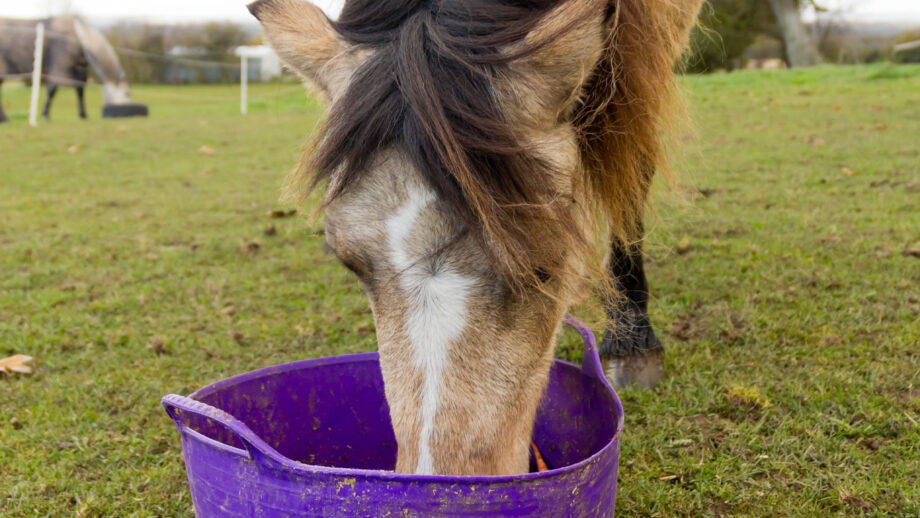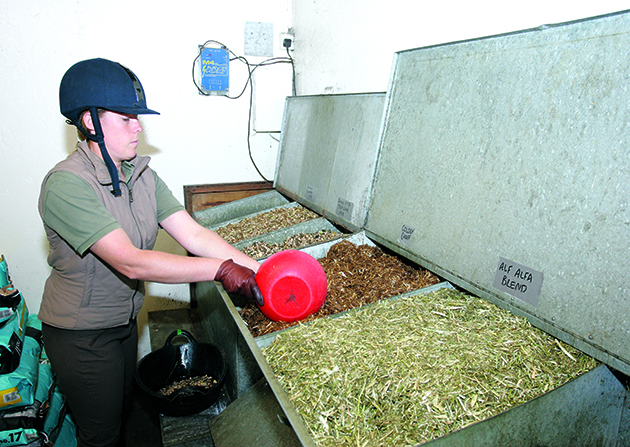Just like our own human diets, information on feeding horses for gut health can feel at best overwhelming and at worst contradictory. With so many opinions in the ether, how can we make the best nutrition programme for our horses that will actually maintain a healthy gut?
The first port of call is to take the advice of a registered equine nutritionist, which is exactly what we’ve done. We’ve spoken to the experts to demystify the equine gut and get to the bottom of feeding horses for gut health.
Equine microbiome 101
According to Dr Katie Williams MSc (Dist) RNutr, senior nutritionist at Dengie, no one can overestimate the importance of fibre.
“Over time, the minimum amount of forage recommended for maintaining gut health has increased, largely in recognition of the increased prevalence of gastric ulcers,” she explains. “Fibre provided by forages has other important functions, not least that it is utilised by the immune system-supporting microbiota, or ‘bugs’, that live in the horse’s digestive system.
“Beneficial microbes in the digestive tract help to keep potentially harmful ones at bay by out-competing them for resources. If we keep the good bugs well-fed and in an environment they prefer i.e. not too acidic, they should thrive. If we don’t give them enough to eat, they will start to digest the mucus that lines and protects the gut.
“If the mucus layer is eroded, a phenomenon known as leaky-gut syndrome can occur. This means that things that shouldn’t pass through the gut wall can then do so, potentially compromising the horse’s health.”
Feeding a fibre-rich diet is key to keeping the good bugs in the equine gut well fed. Horses who maintain a healthy weight on ad-lib forage are of least concern, but horses prone to weight gain present a challenge.
“If you have a good doer you’re very likely striving to find a balance between feeding enough to maintain gut health but without resulting in excessive weight gain,” remarks Katie.
So, how much fibre is enough? “For long-term health and well-being, a minimum of 1.5% of current body weight on a dry matter basis is recommended to be fed.”
Equine gut bacteria: can I give them a boost?
“Ingredients that support the microbes in the digestive tract are collectively referred to as digestive aids and would include probiotics, prebiotics and more recently postbiotics,” says Katie. “The first point to note is that there are no bacterial probiotics approved for horses, so anything labelled as a probiotic should only contain live yeast.
“Prebiotics, like the ADM Protexin In-Feed Formula in Dengie Healthy Tummy, are not live but are substances that only impact bacteria in the digestive tract – the horse can’t use them as an energy source, for example.
“The relatively new term of postbiotics is a definition introduced to describe inanimate microbes and their components that have been shown to have an effect on the microbial population in the gut.”
Using any of these digestive aids or gut balancers should help to maintain a healthy digestive system and are arguably even more important when horses are challenged by low fibre diets, high levels of stress and medication.
Winter gut health for horses
Equine management is seasonal, so how do we know we are feeding horses for gut health as their routine and menu changes?
“The equine digestive system thrives on consistency,” says Dr. Stephanie Wood PgDip BSc (Hons) RNutr, head of nutrition at Dodson & Horrell. “Yet the changes in management and feeding that often take place in autumn and winter challenge this status, increasing the risk of digestive disturbance.”
As well as feeding a variety of fibre sources to help increase the diversity and stability of gut bacteria, Stephanie also advises owners to be mindful of feeding too much starch.
“Guidelines are to feed a maximum of 1g of starch and sugar combined per kg of body weight per meal,” she explains. “So you simply use the horse’s body weight and convert that to grams to give you the maximum amount of starch and sugar per meal, e.g. 500g for a 500kg horse.”
While staying within these guidelines is easy for horses in light work or prone to weight gain, owners of poor doers and competition horses with a higher workload going into winter have a slightly trickier task.
“Feeding within these guidelines is also possible by splitting the daily amount of feed into multiple meals; most people do this with a morning and evening feed,” says Stephanie.
“The ideal feeds for those needing more energy are those containing a variety of energy sources as they reduce the reliance on starchy cereal grains. For horses that prefer to eat a cube, Dodson & Horrell ERS Cubes are the ideal choice due to their multiple fibre sources, controlled levels of starch and elevated levels of oil and vitamin E.
“For those who prefer a muesli, Dodson & Horrell Elite Sport Muesli is the ideal option as it shares the same nutritional qualities.”
The best of both worlds
While traditionally mixes and cubes have been seen as the energy source in a horse’s bucket feed, given the right circumstances it’s possible to meet a working horse’s energy requirements with fibre alone.
“Some short chopped fibre feeds, such as Spillers Ulca Fibre, contain added vitamins and minerals, which means they can be fed as a full or partial replacement for traditional compound feeds, such as mixes and cubes,” says Sarah Nelson BSc (Hons), product manager at Spillers.
“This combines the benefits of reducing starch intake and extending eating time at meals, which helps horses produce more saliva and provide a natural buffer to stomach acid. “Therefore, where possible, adding a chopped fibre such as Spillers Alfalfa-Pro Fibre to each meal is hugely beneficial for gut health.”
Katie adds: “Scandinavian researchers (Jansson and Lindberg, 2011) did exercise tests with horses just fed on haylage, and they were performing comparably to horses on more traditional rations. Subsequently, Martin et al (2023) have shown that high-quality fibre like alfalfa fed alongside much lower levels of cereals than are traditionally used, can also support elite equine athletes.
“As long as you put the good enough quality fibre in, so they’ve got the energy substrate to use, horses can make use of it – performance isn’t compromised by doing that and there are a number of long-term health benefits to reducing starch intake and feeding more fibre.”
Katie says Dengie’s Alfalfa Original is comparable to a light mix in terms of energy provision. “It does need to be used in line with a balancer or vitamin and mineral supplement.”
“Dengie Cool, Condition and & Shine, when fed at the recommended rate, is a complete feed that’s equivalent to a medium energy mix.”
Equine management is seasonal, so how do we know we are feeding horses for gut health as their routine and menu changes?
Feeding horses for gut health: a vet’s three easy ways
Unrestricted water, fibre mats and adlib forage — Caroline Hughes MRCVS explains the science behind her three golden feeding rules, and why you must follow them in order to keep your horse happy and healthy…
1. Provide unrestricted access to water
- This is perhaps the most important rule of them all, because a horse’s body is approximately 80% water.
- Horses should drink around 50ml per kg in 24 hours — that’s about 25 litres a day for an average 500kg horse.
- Fluid demand rises if a horse has been sweating, is lactating or eats dry hay.
- Fresh grass contains moisture, so horses may appear to drink less after grazing.
- Signs of dehydration include dark urine that has a strong smell and dark pink/red gums that feel sticky and take more than two seconds to return to their normal colour after being pressed.
2. Feed before exercise
- The school of thought used to be that we shouldn’t feed a horse before they are worked but actually, due to the stomach’s sensitive lining, riding on an empty tummy is bad news.
- Stomach acid is produced in the lower (glandular) half of the stomach, which has a thick protective lining. However, the upper (non-glandular) part of the stomach does not.
- Therefore, an empty stomach results in acid splashing around and hitting the top of the stomach, risking ulceration and discomfort.
- Feeding at least a handful of chaff/hay prior to work provides a fibre mat to protect the stomach.
- Do not feed concentrates prior to exercise, however, due to the risk of colic.
3. Feed adlib forage
- Horses are designed to be continuous grazers and, as herbivores, require a high-fibre diet.
- Those that live out 24/7 spend 75% of their time eating, which equates to 18 hours a day.
- When stabled, small-hole haynets can prolong eating time to avoid long periods without food.
- Providing two sources of forage — perhaps hay on the floor and a haynet — solves the problem of not restricting forage intake while ensuring their supply lasts for longer.
- Horses are hindgut fermenters, as their hindgut is key to digestion. That is why their diets should be at least 50% good quality roughage.
- Long fibre also encourages chewing, which in turn creates saliva. Saliva is important for digestion and is also a natural pH buffer to stomach acid.
Additional reporting by Aimi Clarke
You might also be interested in:
Top riders and H&H readers share their tips for coping through the winter months — from exercising horses in the

16 gut balancers on the market – and how to choose the best for your horse

Understanding probiotics: your complete guide

Helpful tips for feeding a good doer that lives out during the winter

How to save money on horse feed this winter without skimping

Pot Noodles, tennis balls in troughs and other winter survival tips

Subscribe to Horse & Hound magazine today – and enjoy unlimited website access all year round
Horse & Hound magazine, out every Thursday, is packed with all the latest news and reports, as well as interviews, specials, nostalgia, vet and training advice. Find how you can enjoy the magazine delivered to your door every week, plus options to upgrade your subscription to access our online service that brings you breaking news and reports as well as other benefits.




